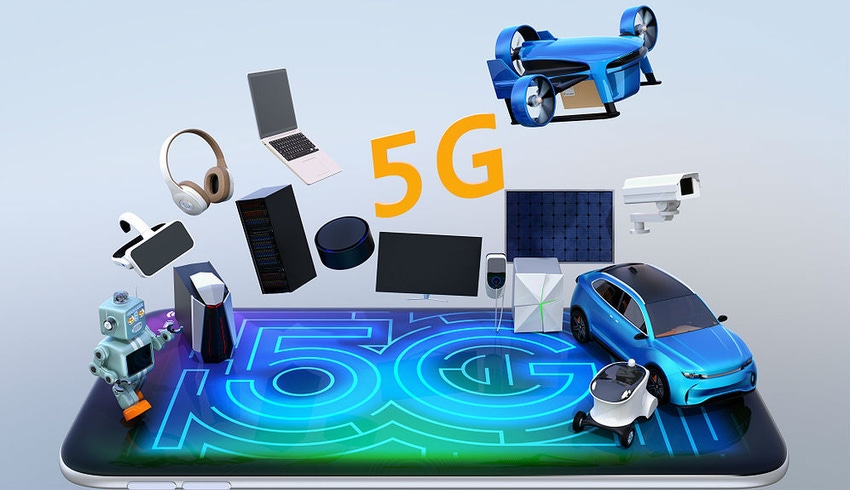There's a lot of hype around the new technology, but how can partners apply it to their practices?
August 26, 2019

By Jeffrey Schwartz
Few things are hyped more than the coming of 5G and Wi-Fi 6 when it comes to next-generation wireless networks. Nevertheless, both new wireless technologies must be part of any discussion with a client looking to deploy a new network or upgrade an existing one.
Neil Anderson is an expert on both 5G and Wi-Fi 6 and will share insights from his discussions with customers at next month’s Channel Partners Evolution in Washington, D.C. Anderson is director of the network solutions practice at World Wide Technology and his session, “Wi-Fi 6 and Your Customers,” Sept. 10, part of the 5G and Wi-Fi track presented with Light Reading and sponsored by Nextiva, will explain how to help customers understand what decisions they need to make.

WWT’s Neil Anderson
In advance of next month’s conference, Anderson talked with Channel Partners about both some of the long-tail technical and business considerations and implications of these new technologies.
Channel Partners: What are you seeing right now with Wi-Fi 6? Quite a few vendors have rolled out new access points that support Wi-Fi 6 but it doesn’t appear there are many endpoints yet that support it. So what do you advise clients about whether they should deploy it knowing that they will see little benefit from it in the short term?
Neil Anderson: We see a couple of things. An awful lot of our customer base skipped over Wi-Fi 5 [aka 802.11 AC] and are running with their Wi-Fi 4 [802.11n] network. A lot of customers were skeptical of the AC value. They typically said, “You know, I just did a refresh, do I really need to do another one when what we have works pretty well?” But what we’re also seeing is that the way people are using the network, wireless has become the primary network. And for new deployments, most are building out more modern office spaces that don’t lend themselves to wired access. And most of the Wi-Fi 4 networks were never built for that type of usage.
Hear from Anderson and dozens of other industry experts at Channel Partners Evolution, Sept. 9-12, in Washington, D.C. It’s not too late to register! |
CP: And Wi-Fi 6 is built for that type of usage?
NA: The trend we are hearing is, ‘If I’m going to refresh, I’m going to wait for Wi-Fi 6.” I believe we’re going to see a pretty big wave. And we’re starting to see some pretty big replacements of those older networks, with the newer networks, for sure. As that happens, you can’t necessarily just pull down the Wi-Fi 4 [access point] and put up a Wi-Fi 6 AP. Wi-Fi 6 is going to take a little bit of redesign of the network, which includes taking a fresh look at where your access points are.
CP: Do the Wi-Fi 6 APs need to be deployed differently?
NA: You’re going to probably need more of them just because of the way they the Wi-Fi 6 standard works. To get those theoretical speeds, or even close to them, you have to be closer to the access point. That’s just a fact. And a lot of those older networks our customers put out there, as kind of a network of convenience in …
… conference rooms and the cafeteria or common workspaces, won’t be enough for these new scenarios. It’s not just going to be about coverage; it’s really going to be about capacity and design, where it’s going to take more APs to cover the workspace for the number of users and devices that are using it. And that’s what’s super important. It’s not really going to be about coverage. It’s going to be about capacity and devices this time.
CP: Is there a standard number of wireless hotspots one will need in order to cover certain amounts of space? Is there a specific formula one might use when going to Wi-Fi 6 that differs from how people mapped out how many hotspots to use, and where to install them, with Wi-Fi 5 and earlier versions?
NA: That’s what’s tough about wireless. It’s highly dependent on the physical space. And, also, where did people put their access points yesterday. Some people may be able to do the swap. It depends how they designed it previously. But I also expect we’re going to have to go in and do site modeling using tools to model what’s the best deployment look like for a specific environment. I don’t think there’s any rule-of-thumb formula where you can figure that out.
CP: How does one determine what tools to use to estimate the proper number of hotspots for a given implementation?
NA: There have been tools for quite a while to do those kind of physical surveys, where you go out and take a laptop and an access point that’s been put in a special mode to let you see what the signal propagation looks like. And then you can ingest and take those different data points and create the right models. But today the tools have gotten a lot more sophisticated. You can literally pull down a Google image of a floor space. Or it’s better if you have a CAD drawing of a floor layout, import that into a tool — even get manufacturer-specific tool where you can say, “I’m trying to build a Cisco Wi-Fi 6 network, or I’m trying to build an Aruba Wi-Fi 5 or Wi-Fi 6 network.” These tools have the wireless RF patterns built into them, so that you can model this without ever visiting the physical space in many cases. They create what’s called predictive surveys.
CP: What are some of the tools used for this?
NA: I’m referring to tools like Ekahau and AirMagnet. Those are the primary two; we’ve kind of standardized on Ekahau, because we found that they have the best 3-D modeling, and it lets you account for multistory buildings.
CP: If you’re going into a smaller organization, perhaps even a greenfield setup, would you encourage that the prospect to go with Wi-Fi 6, even if they’re working with a tight budget?
NA: I would, because it’s going to be the future. If you go with Wi-Fi 5, you’re not really future-proofing yourself very well. Now there is going to be a bit of a premium typically, because not only are we talking about the wireless access points, but the network switches that those are attached to have higher bandwidth. So, they’re inherently going to be a bit more expensive. It’s that ripple effect on your network. But I would still advise customers to …
… do it. Because you’re going to be able to live on that for probably four or five years.
CP: Now as you know, companies such as Cisco and Aruba have started rolling out Wi-Fi 6 gear. But what about the limited number of endpoints that support that and use the Wi-Fi 6 capabilities?
NA: That’ll definitely be part of the transition. I haven’t seen it in laptops yet. You’re starting to see it in smartphones, which tells me that we are probably a year away from starting to see it appearing in laptops and tablets.
CP: Are you seeing customers starting to roll out the early Wi-Fi 6 infrastructure that’s been delivered? Or are should they wait until the standard is finalized next year?
NA: There are some who don’t want to be the first guinea pig, but I can tell you, of the big network refreshes we’re in the middle of planning for customers, their assumption is that Wi-Fi 6 will be there.
CP: Since you’ve spent time testing Wi-Fi 6, can you explain what the experience is like? By that, I mean, what will end users notice that’s different?
NA: People will see faster transmission of larger files. And the second thing that you’ll notice is, depending on your usage, battery life of your device is better because you’re getting off the network a little faster.
CP: Are you advising customers to deploy Wi-Fi 6 with a single vendor? Have you tested it in a multivendor scenario yet?
NA: We’ve haven’t tested multivendor because typically, the way that you manage the access points is very tied to a specific vendor and their management platform. Let’s be honest, Cisco has little interest in managing non-Cisco access points, and the same is true with everyone else.
CP: What about 5G? Are organizations thinking about Wi-Fi 6 and 5G holistically, especially those that might be thinking about deploying enterprise 5G capabilities?
NA: Well, I think, you know, the organizations that we serve, and I have to caveat that we see the large organizations, we don’t really do a lot with the small and medium business. With the large enterprises, what we see there is confusion. There’s a message coming out from the service provider community that 5G is going to solve everything, so why are you investing in a Wi-Fi network? And it causes customers to pause a little bit. When they come to us, they want opinions, and they want to know if that is really true.
CP: How do you answer that?
NA: What we see is that it is complimentary. Without getting into the detailed science of it, there’s only so much spectrum that the public service providers have. And there’s just no possible way to give everybody that kind of bandwidth. That’s why Wi-Fi 6 just makes sense as a complimentary technology, because it makes the physics work. You need an offload network that’s local. You can’t have everybody on 5G; there’s just not enough spectrum to do that at the speeds that we’re talking about. It’s a physics problem. So it makes sense to distribute that load. You use 5G when you’re in the field and you don’t have access to a local network. But when you have access to it, why wouldn’t you …
… offload that to Wi-Fi 6, which is an incredibly efficient technology?
CP: That makes sense, not just based on the physics but the economics, right?
NA: True. It’s actually cheaper to deploy than a 5G network, when you think about the secondary gear that has to be bought, such as the 5G chipsets, which are very expensive compared to a Wi-Fi chipset. I can’t remember what the multiple is, but I’ve seen stats of like 10x or 20x, the cost to make a 5G chip versus a Wi-Fi 6 chip.
CP: How long will it take for Wi-Fi six become ubiquitous? Will it happen at a faster pace than previous wireless standards?
NA: I think it will happen at a faster pace. But I think it’s going to take a while for organizations to absorb the ripple effect through their network, which may artificially slow that down a little bit.
CP: Are organizations generally considering the network backbone impact or do many still deal with these in separate silos?
NA: Smart organizations are doing it holistically. Not every organization is doing that, but as a partner, that’s what we recommend to clients and try to educate them before they make decisions. We’re having a holistic conversation about enterprise architecture and connectivity. And from wireless into the switching network, across the WAN and out to the cloud, wireless becomes a phase of a larger, modernization project.
Read more about:
AgentsYou May Also Like
